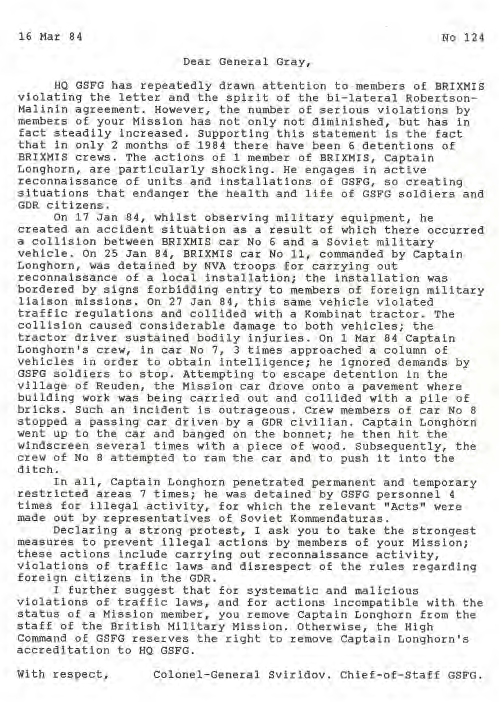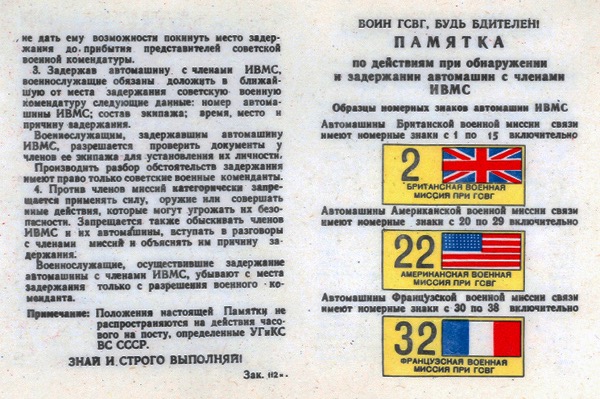
Bob Longhorn's Soviet CV

[Submitted by Bob Longhorn]

Soviet Mission Reporting Card

 The Soviet View Of The Missions
The Soviet View Of The Missions
This article was first printed in Krasnaya Svezda on Wednesday 11 January 1988 and subsequently in Neus Deutchland on Friday 13 January 1988. It was translated and presented to the BRIXMIS Club by Capt Colin Ward RE (Jul 86 – Apr 89), who somehow managed to avoid having his own escapades made public.
On the roads of the DDR you often see the squat camouflaged shapes of Mercedes, Opel or similar type cross-country vehicles made by Land Rover or Ford. Not on every road of course, but only on those which go near military garrisons of the forces of GSFG. They appear on the military ranges, near railways along which military equipment travels, and they “accompany” military columns; this often causes road traffic accidents.
Who are the owners of these machines, the numbers of which are not registered with the DDR police? Who are they, who every year complete more than 3,000 of what are certainly not tourist trips, to the military installations of the Armed Forces of the socialist states?
Officially they are members of the British, American and French Military Liaison Missions, accredited to the C-in-C GSFG. These missions were created after the Second World War on the basis of ‘agreements concerning the control mechanism in Germany’ from 14 November 1944, and were intended solely to support communications between the C-in-C’s of the Armed Forces of these states. In time the military missions had in reality, changed into branches of military reconnaissance for the USA, Great Britain and France.
The liaison missions are made up of experienced specialists, who have been trained in intelligence centres, like the US Army Russian Institute in the West German town of Garmisch-Partenkirchen, the Institute of Eastern languages in Paris and the Beaconsfield Intelligence School in the UK. A number of the personnel of the military liaison missions have gained their professional skills as Military Attaches in the embassy is of their countries based in the capitals of the socialist states, and in other intelligence organs of the British, American and French armed forces, as well as in the sub-units of specialist troops such as Rangers and Green Berets. The character of the work carried out by members of the Missions is directly reflected by their equipment. The spies take with them a large number of optical, photographic and video equipments, dictaphones and special radio receivers. At their disposal are highly mobile vehicles. On their spying missions, the western "missionaries" regularly ignore demarcation lines of forbidden areas laid down by HQ GSFG, which are clearly signed. In 1987-1988 alone, military personnel dozens of times stopped the unauthorised actions in these areas of crews from vehicles of the Allied missions.
A persistent offender in the violation of the current agreements concerning the Military Missions was the American military spy Capt Bennet McCutcheon. In order to collect information about the troops of GSFG, he violated on 16 occasions the boundaries of the forbidden areas, and carried out insolent hooligan escapades. The spying career of the Captain came to an end after his final particularly impudent act, and following a protest by the Soviet High Command he was hastily drummed out of the American Mission. Such provocative actions are also carried out by personnel of the British Mission; for instance in the area of one of the military installations, the activity of Flt Lt David Browne and several of his colleagues was stopped. The military spies were so distracted by their video and if photographic that they were caught red-handed at their work by Soviet military personnel. Large quantities of specialist spying equipment were taken from the Englishman including night vision equipment, a video camera with microphone, and photographic equipment with special attachments. The Chief of Mission, Brigadier John Foley called the spying tools "standard equipment". However, the proof produced by the Soviet high command completely exposed the spying nature of Browne’s activities, and a written protest was passed to the British in the name of C-in-C GSFG. The Soviets reacted in the same way concerning the unpleasant activities of the following members of the French Mission; Lt Saby, Sgt-Major Bock and Sgt Brunet. They were taking photographs of landing aircraft from a wooded area on the centre-line of a military airfield. Saby was photographing aircraft from the jeep, using a telephoto lens. Bock was using a long-range lens and Brunet was observing with a pair of binoculars. Soviet military personnel put a stop to the activities of these "photographic lovers" and took away their spying materials.
In order to gain spying information Mission members don't just use technical means, but they do attempt to make contact with Soviet military personnel trying to get, in the course of conversation, important information. Such attempts were repeatedly made by Capt Stephen Harrison of the British Mission.
In their efforts to get this secret information, "missionaries” deliberately indulge in nasty violations of law and order, as laid down on their actions in the DDR. In achieving this they manage to distort the truth by misrepresentation of the facts, and they attempt to lay the blame for individual incidents on the Soviets. As an example, speculation was rife concerning the tragic result of the penetration into the Soviet military installation by the American, Maj Nicholson, who did not obey the orders of a sentry. Such irresponsible actions show the danger to life not only to Mission members themselves but also to Soviet military personnel and civilians. In March 1988 the French military spies headed by the deputy chief of their Mission Lt Col Demay, ignored the order of a Soviet Regulator to stop, whilst following a military column. As a result, the Regulator ended up on the bonnet of the Mercedes. Not only did the Frenchmen not stop, but they also increased speed and stopped about three kilometres away in front of a large wood. There are numerous similar incidents we could quote.
The developing process of the strengthening of measures of trust, in such a sensitive area as the military one, demands absolute and exact adherence by both parties to their obligations. Any attempts to suffer these commitments, for whatever reason, only delays the further development of positive relations as well as the process of detente.
[Submitted by Bob Hamilton]

NVA Report On Incursions
A report to the GDR National Defence Council by the commander of the NVA, Colonel-General STRELITZ, on incursions by western missions into Restricted Areas in 1981; reveals that allied military missions accredited to GSFG entered Restricted Areas illegally on 77 occasions, an increase of 31% over the 1980 figures.
The report states that BRIXMIS was involved 46 times (59%), USMLM 22 times (29%) and FMLM 9 times (12%). He states that facilities belonging to ground and air forces were primarily affected, in particular in the Magdeburg, Frankfurt/Oder and Cottbus districts.
The main incursions recorded concerned:
SAM battalion 311, which was setting up firing positions.
SigInt battalion 61, for which a Command Post was being set up.
Pontoon regiment 5, which was involved in a joint NVA / GSFG exercise on the Elbe
Armoured Regiment 14, where a new type of tank was suspected. [!?]
Artillery regiment 7, where artillery pieces were being converted to SP equipment.
STRELITZ considered it essential that a greater effort should be made to co-ordinate checks on the movements of the western military missions in the GDR.
[Provided and translated by Mike Barton]

The Stasi View Of The Missions
Extract from the Second Edition of Das Wörterbuch der Staatssicherheit Published by the Stasi Law School in 1985
Special groups of military personnel of the three Allied powers, who exceed their legal functions in order to carry out subversive activities. The Military Liaison Missions of the Commanders-in-Chief of the armed forces of Great Britain the USA and France that are stationed in the Federal Republic of Germany and operate on the territory of the German Democratic Republic (except in Berlin, the capital). The missions were set up and exchanged in 1946/1947 in accordance with the Agreement of the Control Machinery in Germany, which was signed on 14 November 1944 and which was based on bilateral agreements in the individual zones of occupation for the exchange of military liaison missions (the GSFG missions operate in the Federal Republic of Germany).
The western missions are accredited to the C-in-C, HQ GSFG. Their function is to maintain a permanent and direct link between the C-in-C GSFG and the Cs-in-C of the western forces in the FRG. Appropriate to their function and associated tasks, the missions and their members were granted specific rights, and certain obligations were imposed. These were subsequently defined more precisely in accordance with the sovereign rights and security interests of the GDR and USSR and with normal practice. In implementing their sovereign powers vis-à-vis the Military Missions, the GDR takes into account the interests of the USSR connected with the activities of the Soviet mission in the FRG.
The western missions have been granted the following rights in order that they may implement their missions:
The inviolability of the Military Missions, including their vehicles and mission personnel.
The use of couriers and liaison personnel to ensure unhindered communication between the missions and the HQs of their respective C-in-Cs. These enjoy the same immunity as do diplomatic couriers.
The operation of a wireless station.
Freedom of movement and travel for members of the missions within the GDR, other than in the capital, in PRAs and TRAs, on routes to installations and facilities of military, economic and political importance where access has been denied to the missions by means of Mission Restricted Signs.
Moreover, mission members are permitted to make use of hotels, catering facilities, shops and petrol stations, to visit sporting and cultural events, to use the telephone system of the GDR and to pay in GDR currency.
Mission members are obliged to:
Conform in the GDR to the standards of behaviour as laid down by the C-in-C GSFG.
Respect the laws of the GDR, not to offend public order and, amongst other things, to observe the highway code of the GDR.
Comply with instructions issued by guards and traffic controllers appointed by the Soviet armed forces, the East German armed forces and the Peoples' Police.
Wear the uniforms, with their badges of rank, of their respective armed forces when travelling through the GDR, and to use only the vehicles of the military missions with the prescribed licence plates.
Amongst other things, Military Missions are forbidden to:
Photograph, observe or to accompany troops and military equipment, convoys, railway facilities during loading and unloading of troops and military equipment.
Observe or photograph sites and facilities that are of military, economic or political importance.
Operate equipment and other items that can be used for intelligence or spying purposes.
Carry out anti-social agitation or propaganda activities or to act in a provocative manner.
In contrast to their rights and obligations, the military missions and their members, who are specially selected military specialists from the army and air force who have been trained in intelligence matters, are particularly active in the field of military espionage and pursue this in a subversive manner by exploiting and misusing the aforesaid rights and obligations. They are thus of significant importance for the imperialist secret services and their military intelligence organs.
The military intelligence activities of the western missions against the GSFG and the armed organs of the GDR are mutually coordinated and are directed primarily against airbases, air combat and transport means, hangars and radio navigation systems, anti-aircraft defences, including telemetry and fire control equipment, ranges and training areas, weapons and munitions stores, command centres, important military projects, fixed movement routes, river crossing points, transport nodal points, loading/unloading locations for military trains, certain facilities in the GDR used for military purposes, etc.
To obtain secret information on military and economic matters affecting the military, the mission members try, amongst other things, to establish contact with specific persons, including members of the armed organs of the GDR, in order to obtain information from such people and to identify others who would be suitable for intelligence work.
Under the existing and future conditions of the class struggle, the Ministry for State Security has an increasing number of tasks to implement in conjunction with the GSFG military counterintelligence authorities and other organs of state of the GDR, in particular the Peoples' Police, to further restrict the intelligence operations of the missions, to reveal, initiate prophylactic measures against, to prevent, and to obtain documentary evidence of the subversive abuse of mission rights and other transgressions by their members. Depending on the nature and severity of the subversive abuse of these rights and authorised activities and on any other transgressions, the relevant organs of the GDR may apply the following measures against mission members:
The systematic use of uniformed or plain clothes personnel to disrupt possible or implemented intelligence operations by the missions.
'Sandwiching' of their vehicles when it is evidently clear that mission members intend to operate, are operating or have operated illegally.
Prevention of the removal of evidence of illegal activities by the missions, but with due respect to the inviolability of the individual, the mission members and of their vehicles
When Military Missions have committed illegal activities, organs of the GSFG are authorised to seize any evidence, to detain the personnel and to take them to the local garrison commandant's office to clarify the matter.
[Provided and translated by Mike Barton]